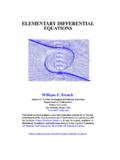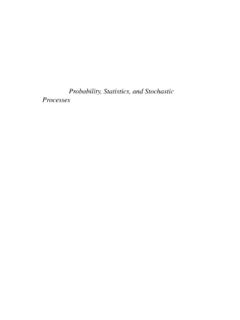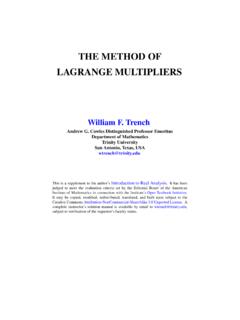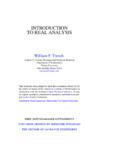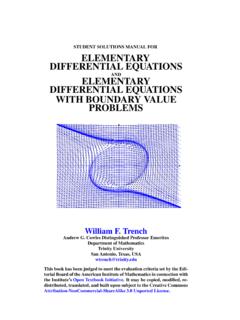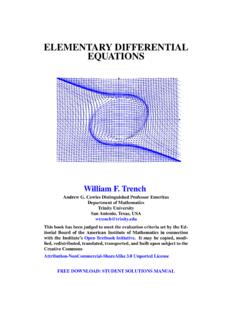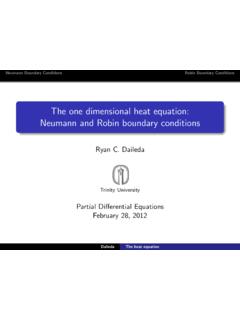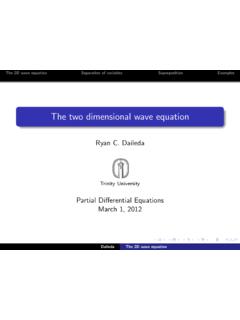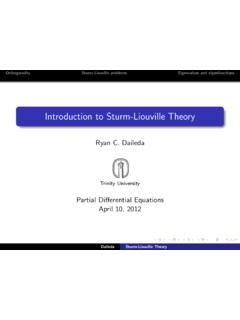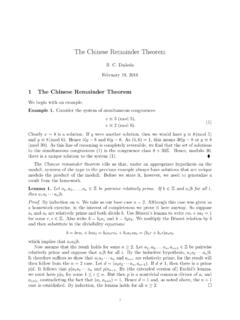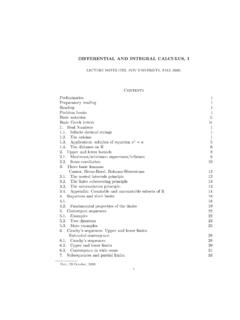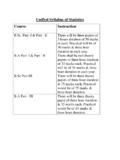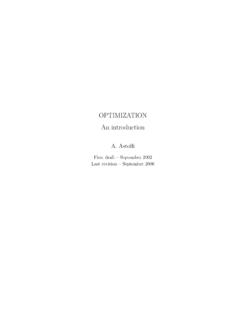Transcription of Improper Integrals - Trinity University
1 Improper IntegralsR. C. DailedaBy animproper integralwe will mean an integral of the form af(x)dx.(1)The goal of this note is to carefully define, and then study the properties of, improperintegrals. To this end, leta Rand letfbe a function that is Riemann integrable on everyfinite subinterval of [a, ). We then define af(x)dx= limA Aaf(x)dxprovided the limit on the right-hand side exists. In this case we say that the improperintegral (1)convergesand that its value is that of the limit. Otherwise we say (1) turns out that the theory of Improper Integrals closely mirrors that of infinite series, andwe will prove several results which can be viewed as direct analogues of results about example, one can use the usual limit laws to immediately verify that Improper Integrals (when convergent) obey the usual linearity of definite Integrals .]
2 Another more powerfulresult is the following alternate formulation of 1( cauchy Criterion).The Improper integral(1)converges if and only if for every >0there is anM aso that for allA,B Mwe have BAf(x)dx < . that the Improper integral converges toL. Let >0. Using the definitionof convergence, chooseM aso large that ifA Mthen Aaf(x)dx L < ifB Mas well we have BAf(x)dx = Baf(x)dx Aaf(x)dx = Baf(x)dx L+L Aaf(x)dx Baf(x)dx L + L Aaf(x)dx < 2+ 2= .That s the easy implication. For the converse, now suppose the stated cauchy criterionholds.
3 For natural numbersn aletan= naf(x) >0 and chooseM aas stated in the hypothesis. Then ifm,n Mwe have|an am|= nmf(x)dx < ,which shows that{an}is a cauchy sequence. Let its limit beL. Again let >0 and thistime chooseM aso that|an L|< /2 and BAf(x)dx < 2whenevern,A,B M. IfA M+ 1 then [A] Mso that Aaf(x)dx L = [A]af(x)dx L A[A]f(x)dx |a[A] L|+ A[A]f(x)dx < 2+ 2= .This proves that the Improper integral in question converges say that the Improper integral (1)converges absolutelyif the Improper integral a|f(x)|dxconverges. Perhaps not surprisingly, absolute convergence of an Improper integral bears thesame relationship to ordinary convergence as in the case of infinite series.
4 Specifically wehave the next 2(Absolute convergence implies convergence.).If the Improper integral(1)con-verges absolutely then it make use of the cauchy criterion. Let >0. Since the Improper integral of|f(x)|converges we can find anM aso that for allA,B Mwe have BA|f(x)|dx < .But the integral of|f(x)|is nonnegative, so we have BAf(x)dx BA|f(x)|dx < which proves that the Improper integral off(x) satisfies the cauchy criterion, and with infinite series, it is often the case that one can prove convergence of an improperintegral even though one cannot give a closed form expression for its limit.
5 An example isthe integral 1t [t]t2dtwhich is simplydefinedto be the constant = We would therefore like to havea way of testing for the convergence of an Improper integral without having to evaluate are some common 3(Comparison Test).Suppose thatfandgare Riemann integrable on everyfinite subinterval of[a, )and that0 f(x) g(x)for allx a. If ag(x)dxconverges,so does af(x) aLetF(A) = Aaf(x)dxandG(A) = Aag(x) hypotheses imply thatF(A) G(A) and that both of these functions are ,G(A) tends to a limitLasA . It follows thatF(A) G(A) (A) is increasing and bounded above byL, it must also converge to a limit asA ,which is what we needed to frequently need a means to apply this test even though the Improper Integrals inquestion do not have the same lower limit.]
6 This can be achieved by making use of the Riemann integrable on every finite subinterval of[a, )andb a, then af(x)dxconverges if and only if bf(x) bthen the integral appearing in the cauchy criterion for both improperintegrals is the same. The result follows at often will find it convenient to make comparisons with Improper Integrals of the form 11xpdxwherep >0 is a fixed real number. Ifp6= 1 we have A11xpdx=x1 p1 p A1=A1 p1 p+1p <1 then this diverges asA , whereas ifp >1 this tends to the limit 1/(p 1) asA . Ifp= 1 then we instead have A11xpdx= lnAwhich diverges asA.]
7 We can summarize these computations as 11xpdx={1p 1ifp >1, if 0< p the comparison test can be quite useful, there are times when directly comparingthe integrands of two Improper Integrals is inconvenient. In this situation one can oftenappeal to the following 4(Limit Comparison Test).Suppose thatfandgare nonnegative and Riemannintegrable on every finite subinterval of[a, ), and thatlimx f(x)g(x)=Lexists. If ag(x)dxconverges then so does af(x)dx. IfL6= 0then the converse = 1 in the definition of the limit, we find that there is anM aso thatfor allx Mwe havef(x)g(x)< L+ the functions in question are nonnegative this gives 0 f(x) (L+ 1)g(x).]}
8 If weassume that ag(x)dxconverges, then so, too, does M(L+ 1)g(x)dxby linearity and thelemma, which according to the comparison test tells us that Mf(x)dxconverges as appeal to the lemma gives the result. The final statement of the theorem followsfrom the first sincelimx g(x)f(x)=1 Lin this the hypotheses of the Comparison and Limit Comparison Tests only apply tononnegative integrands, we can apply them more generally by taking the absolute value of anintegrand prior to using the test. In both cases the tests are then for absolute be a bit more specific, given an arbitrary integrandf, we instead consider|f|and compareit to a nonnegative integrandgwhose Improper integral converges, thereby demonstratingthe absolute convergence of the Improper integral off.
